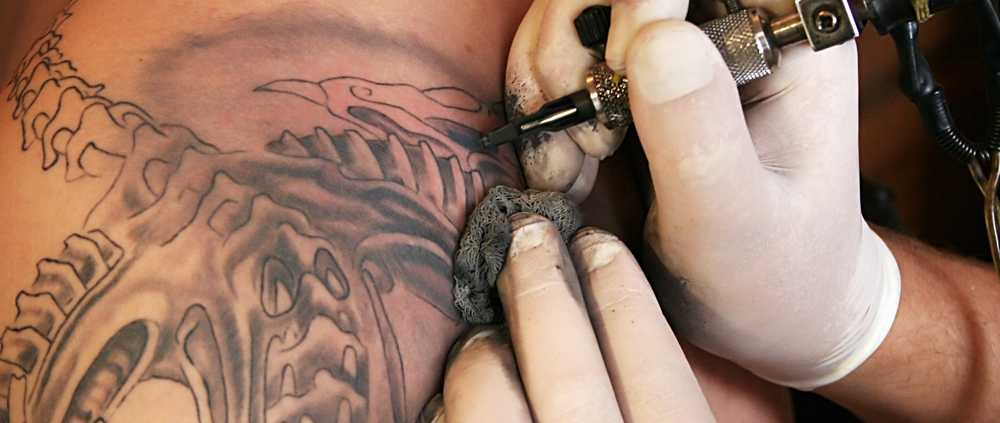How Deep Into The Skin Does a Tattoo Needle Go?
The scariest thing about getting a tattoo? For most people, it’s the needle. You worry that the pain may be too much, or that the needle might go too deep. Fortunately, finding yourself a professional and practiced tattoo artist ensures the highest quality of artwork and a fun experience. That is why we want to talk about how deep into the skin the tattoo needle goes, as well as the mechanics of the tattoo machine and needle. By familiarizing yourself with how things work, you can be less anxious and more excited about getting a new tattoo.
How Does a Tattoo Machine Work?
There are many methods of tattooing. Some of them have been used for thousands of years. However, in most contemporary tattoo shops, like Oracle Tattoo Gallery, the tattooists use the modern tools of the trade: an electrically powered machine.
The tattoo machine has a tattoo needle attachment that pushes the needle into the skin at 6,000 times a minute. But the needle isn’t injected ink directly into the skin. Rather, the needle pierces the skin while the machine allows ink to pool on the surface. As the needle retracts, the puncture in the skin becomes a vacuum that draws the ink in deep enough to become permanent.
All About The Tattoo Needle
One of the signs of a skilled tattoo artist is how they manage the depth and pressure of the tattoo needle. Someone who uses a tattoo needle expertly will not only bring about more beautiful images, but they also diminish some of the pain you experience.
Tattoos are typically made of nickel, chrome, or steel. The standard thickness is between 0.30mm-0.35mm, though some needles can be much thinner. Magnum or bugpin needles run around 0.20mm-0.25mm.
Needles also come in different shapes for coloring, shading, and dotting. Round needles, for instance, are used for lines and shading, while flat needles are best for dark lines with cleaner edges.
Regardless of the shape, size, or purpose, all tattoo needles are sterilized before use and disposed of after your tattoo is finished.
Just How Far Does The Needle Go?
Now that you know a little more about the machine and the needle, it’s time to discuss the third essential piece of the puzzle—your skin.
The tattoo needle goes through 1/16th of an inch of skin. That might not sound like a lot of skin, but it is really going through five sublayers of the epidermis, the dermal layer, and also the top layer of the dermis. Among these layers is a collection of sweat glands, hair follicles, connective tissue, fat, and blood vessels.
During a tattoo session, the needle passes through the epidermis and epidermal-dermal junction, opening a passage in the 2mm-thick dermis. The dermis is ideal for a couple of reasons. It is far enough not to bleed out and isn’t exposed.
Knowing this, the tip of the tattoo needle is minutely adjusted to ensure that it enters the skin to the correct depth. If you were to look at a tattoo needle in the machine, you will see that it sticks out no further than 2mm.
What if the Needle is Too Shallow or Too Deep?
Now that you know that a tattoo needle goes about 1/16th of an inch deep into the skin, you might be wondering what happens if the needle is too shallow or too deep.
The epidermis is a poor location for ink. Not only is it exposed to the elements, but it regenerates itself every 3 weeks. This means that any ink that is trapped in the epidermal layers disintegrates and fades.
Also, when the needle leaves the skin and ink is sucked in, any bleeding that occurs will push some ink out. If the ink is too shallow under the skin, all the color will be removed before the tattoo even gets a chance to heal. The best scenario is a faded tattoo that will rapidly disappear.
Beneath the dermis is the hypodermis. If that needle sinks that deep, there is a greater chance of complications. Not only will it be more difficult for the ink to leave the skin, but you won’t be able to see it well. You can also expect the tattooing process to be extremely painful. Ink trapped in the hypodermis could even cause infection or tattoo blowout, which the ink moves around the fat layer, distorting the shapes.
Either way, you don’t want that happening.
Does The Ink Transfer to Blood Vessels?
This is a common question. What happens if the needle accidentally injects ink into a blood vessel?
It’s possible. The dermis is filled with blood vessels. That said, a professional tattooist from any of the great Philadelphia tattoo shops will know how to guide needles. Even if a vein gets nicked, issues stemming from that are slim. Toxicity from ink is also prevented by your tattoo artist. That is why they train again and again to keep the needle at a constant 1/16th of an inch and no farther.
There will always be ink transferred through your bloodstream and lymph nodes, however. Certain cells in the dermis take in those pigments and send them throughout your body. Thankfully, the human body has an incredible immune system that can deal with ink.
Conclusion
Hopefully, this explanation has made it easier for you to understand how tattoo machines and tattoo needles work. You should also know how deep the needle goes (hint: it’s 1/16th of an inch) and what could happen if the tattoo artist goes too deep. This information should make it easier for you to decide whether to get a tattoo; you should also want to choose one of the many professional Philadelphia tattoo shops. After all, a true tattoo artist knows how to wield a needle.
Whether you’re looking to get your first tattoo or want to add more ink to your body art, check out Oracle Tattoo Gallery in Philadelphia. Our artists tattooing wizards who want to bring the tattoo you’ve envisioned to life. Give us a call or send us an email to request a consultation today!



